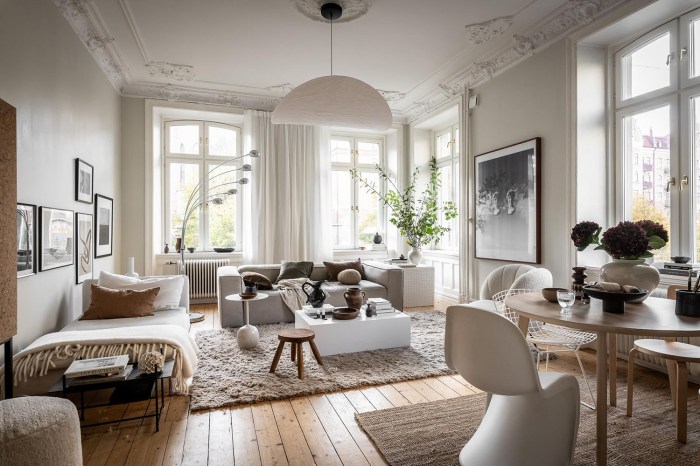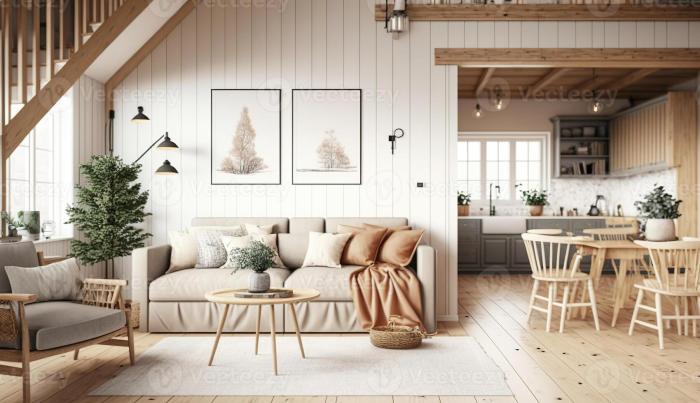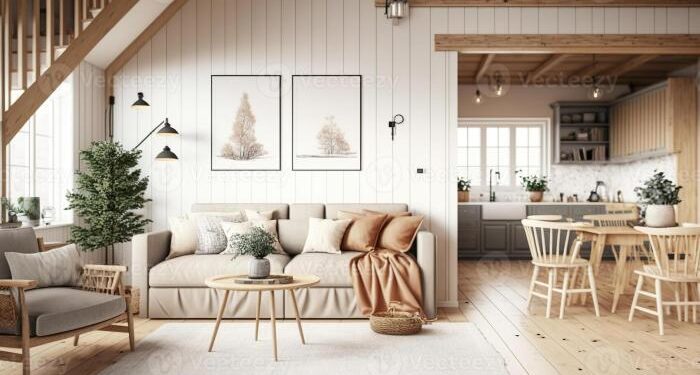Embark on a journey through the world of Scandinavian interior design for cozy homes, where simplicity meets warmth in a harmonious blend. Discover the key elements, color palettes, and design principles that make Scandinavian interiors so inviting and aesthetically pleasing.
Define Scandinavian Interior Design
Scandinavian interior design is a minimalist and functional approach to decorating homes that originated in the Nordic countries. It focuses on simplicity, functionality, and a connection to nature.
Key Elements of Scandinavian Interior Design
- Minimalism: Clean lines, simple forms, and clutter-free spaces are essential in Scandinavian design.
- Functionality: Furniture and decor are not only aesthetically pleasing but also serve a practical purpose.
- Natural Materials: Wood, stone, and other natural elements are commonly used to bring a sense of nature indoors.
- Neutral Color Palette: The color scheme is typically neutral with whites, grays, and light pastels dominating the palette.
Color Palette in Scandinavian Interiors
The color palette in Scandinavian interiors is known for its light and airy feel, creating a sense of spaciousness and tranquility.
- Whites and Off-Whites: These colors are often used as a base to reflect natural light and create a bright atmosphere.
- Soft Pastels: Light blues, greens, and blush tones are commonly used to add subtle pops of color without overpowering the space.
- Earthy Tones: Warm browns, grays, and beiges are incorporated to add depth and coziness to the overall design.
Significance of Natural Light in Scandinavian Design
Natural light plays a crucial role in Scandinavian design, as the Nordic countries experience long periods of darkness during the winter months. Maximizing natural light helps to combat the gloominess of winter and create a bright and inviting space.
Large windows, light-colored walls, and minimal window treatments are common strategies to enhance natural light in Scandinavian interiors.
Incorporating Coziness
Creating a cozy atmosphere is a key element of Scandinavian interior design. This design style focuses on simplicity, functionality, and the use of natural elements to bring warmth and comfort to a space.Scandinavian design achieves coziness through the following ways:
Use of Natural Materials
- Wood: Scandinavian interiors often feature light-toned wood floors, furniture, and accents to create a warm and inviting feel.
- Textiles: Soft textiles like wool, sheepskin, and knitted throws are commonly used to add texture and coziness to the space.
- Plants: Bringing nature indoors with greenery and natural elements helps to create a calming and cozy environment.
Warm Lighting
- Soft, ambient lighting through lamps, candles, and pendant lights helps to create a cozy and inviting atmosphere in Scandinavian interiors.
- Layering different light sources adds depth and warmth to the space, making it feel more welcoming.
Functional Furniture
- Pieces like plush sofas, oversized armchairs, and cozy rugs contribute to the overall comfort and coziness of a Scandinavian-inspired home.
- Functional furniture that serves a purpose while also being aesthetically pleasing is a hallmark of Scandinavian design.
Minimalism in Scandinavian Design
Minimalism is a key aspect of Scandinavian design, focusing on simplicity, clean lines, and functionality. Let's explore how minimalism in Scandinavian design compares with other styles and how to achieve a minimalist look while maintaining a cozy ambiance.
Comparison with Other Design Styles
Scandinavian minimalism is often compared to Japanese minimalism for its emphasis on clean and uncluttered spaces. However, Scandinavian design tends to incorporate more warmth and coziness through the use of textures and natural materials.
Achieving Minimalist Look with Cozy Ambiance
- Stick to a neutral color palette: Opt for whites, grays, and earth tones to create a serene and minimalist backdrop.
- Embrace natural light: Maximize natural light by keeping window treatments minimal to enhance the sense of spaciousness.
- Add texture with textiles: Incorporate cozy blankets, rugs, and cushions made from natural materials like wool and linen to add warmth to the space.
- Select furniture wisely: Choose sleek and functional furniture pieces with clean lines to maintain a minimalist look while ensuring comfort.
Decluttering and Organizing Spaces
Decluttering is essential in achieving a minimalist Scandinavian design. Here are some tips to declutter and organize your space:
- Start with a clean slate: Remove unnecessary items and only keep essentials that serve a purpose.
- Invest in storage solutions: Opt for multifunctional furniture with built-in storage to keep clutter at bay.
- Create designated areas: Define specific zones for different activities to maintain an organized and clutter-free environment.
- Regularly edit and rotate decor: Keep your space fresh by rotating decor items and editing your belongings to prevent overcrowding.
Natural Elements and Sustainability

In Scandinavian interior design, the use of natural elements and sustainability are key components that contribute to the cozy and inviting atmosphere of the space.
Natural Materials like Wood and Stone
Scandinavian interiors often feature natural materials such as wood and stone, which add warmth and texture to the space. Wood is commonly used for flooring, furniture, and accents, while stone can be incorporated in fireplace surrounds or countertops.
Emphasis on Sustainability
Sustainability and eco-friendliness are fundamental principles in Scandinavian design. This means using materials that are sourced ethically and have minimal impact on the environment. Reclaimed wood, recycled materials, and energy-efficient lighting are common choices in sustainable Scandinavian interiors.
Incorporating Plants and Greenery
Bringing nature indoors is a hallmark of Scandinavian design. Incorporating plants and greenery not only adds a pop of color to the space but also improves air quality and creates a sense of tranquility. Examples include placing potted plants on windowsills, hanging planters from the ceiling, or creating a vertical garden on a wall.
Functional and Practical Design

In Scandinavian interior design, functionality and practicality are key principles that guide the layout and selection of furniture and decor. The focus is on creating a space that not only looks beautiful but also serves a purpose in everyday life.
Maximizing Storage with a Clean Aesthetic
One way to maximize storage in a Scandinavian-inspired home is to opt for multi-functional furniture pieces such as ottomans with hidden storage, bed frames with built-in drawers, or wall-mounted shelves. This allows you to keep clutter at bay while maintaining a clean and minimalist aesthetic.
Importance of Furniture Placement
Proper furniture placement is crucial in Scandinavian interior design to ensure that the space is both functional and visually appealing. Consider the flow of the room and how each piece of furniture can be used efficiently. For example, placing a desk near a window for natural light or positioning a sofa to create a cozy seating area.
Outcome Summary
As we conclude our exploration of Scandinavian interior design for cozy homes, remember that creating a space that exudes coziness and charm is achievable through thoughtful design choices and a focus on natural elements. Embrace the simplicity, functionality, and warmth that define this timeless design style for a home that truly feels like a sanctuary.
FAQ Summary
How does Scandinavian design create a cozy atmosphere?
Scandinavian design achieves coziness through a combination of natural materials, soft textures, and warm lighting that create a welcoming and comfortable environment.
What are some examples of furniture or decor items that enhance the cozy feel in Scandinavian interiors?
Items like plush rugs, knit throws, and wooden accents can enhance the cozy ambiance of a Scandinavian-inspired space.
How can one achieve a minimalist look while maintaining a cozy ambiance in Scandinavian design?
Opt for sleek furniture, declutter spaces, and focus on a neutral color palette to achieve a minimalist yet cozy Scandinavian interior.
Why is sustainability and eco-friendliness important in Scandinavian design?
Scandinavian design values sustainability to reduce environmental impact and promote a healthy living environment for occupants.
What is the significance of furniture placement in Scandinavian interior design?
Proper furniture placement is crucial in Scandinavian design to ensure both functionality and aesthetic appeal, promoting a harmonious flow within the space.





